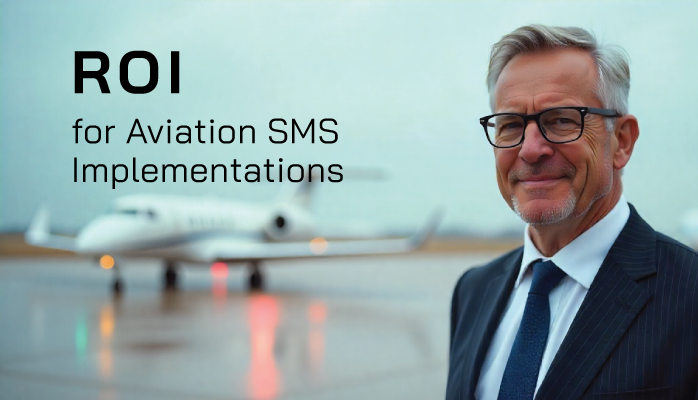How SMS Affects Companies’ Finances

While the safety benefits are often stressed far more than the financial benefits of aviation safety management systems (SMS), this is a mistake. When companies benefit financially from a safety initiative, what this means is that they benefit financially because the safety initiative is actually improving safety.
Return on investment for aviation SMS implementations is actually not as confusing to calculate as you might think. When we talk about return on investment, we talk about how an aviation SMS affects companies' finances.
When it comes to implementing an aviation SMS, there are two wonderful facts regarding SMS and finances:
- Effective aviation SMS initiatives are relatively inexpensive; and
- Negative safety outcomes are often extremely expensive, and preventing even just one accident per year can save organizations many millions of dollars.
Related Aviation SMS Implementation Articles
- Why Should We Implement Aviation SMS?
- Overview of 4 Phases of Aviation SMS Implementation With Free Resources
- How to Create Aviation SMS Implementation Plan - With Templates
Reduce Expenses Implementing Aviation SMS
Small aviation SMS implementations simply require a safety manager, (maybe) an assistant, an aviation safety database, and promotional expenses, such as:
- aviation SMS training;
- safety newsletters; and
- safety posters.
Modern technology like aviation SMS software and automated recurrent SMS training dramatically cut down on promotional costs by removing many hours of manual work. Moreover, preventing even a couple of small safety incidents can more than pay for an aviation SMS' yearly expenses.
Smart managers adopt technologies that amplify the efforts of their safety teams. For example, an aviation SMS database subscription provides aviation service providers with the framework and risk management processes to successfully implement and manage the SMS initiative.
Early Adoption of Technology Reduces SMS Implementation Expenses

For a quick example of capitalizing on technology, consider that a safety manager may spend weeks creating an aviation SMS manual--carefully creating and documenting the organization's risk management processes. In many cases, operators don't have any existing documentation, and in others, they may have considerable documentation from their legacy safety program. Pulling all this together and getting acceptance from the accountable executive and operational department heads will require considerable effort.
In the case of acquiring an SMS database subscription, the safety manager can start with an SMS manual template that comes with industry-accepted risk management processes. This becomes a fast sell to safety managers who can get all the necessary SMS data management tools, plus:
- an SMS manual template;
- predefined, industry-accepted risk management processes;
- safety reporting system; and
- risk management system with alerts and notifications.
Of course, there are other benefits to acquiring an SMS database but they really become evident after about three to five years into the SMS. By this time, your aviation SMS will have accumulated sufficient safety data to allow your company to detect trends and participate more fully in predictive risk management activities.
Related Aviation SMS Database Articles
- 20 Benefits of Aviation SMS Software
- 3 Benefits of Aviation Safety Management System (SMS) Databases
- How to Choose Aviation SMS Software - Educating SMS Professionals
SMS return on investment and safety performance go hand in hand. See the following resources for a very detailed look at aviation SMS ROI.
What Is Return on Investment for Aviation SMS Implementations
Return on investment (ROI) is only looking at two things:
- Investment made; and
- Payback.
Return on investment should always result in a percentage, such as 250% ROI. This percentage is calculated by:
- ( Payback – Investment ) / Investment
Return on investment can be factored for a total yearly ROI, monthly ROI, or ROI on an incident-by-incident basis. Ultimately, calculating ROI is an extremely valuable activity for the whole organization:
- Present to investors to increase investor confidence;
- Present to the public to stimulate consumer confidence and sales; and
- Useful for businesses to project and plan for future investments.
Ultimately, money talks. ROI in aviation safety is not just about saving money, it’s about stimulating confidence in the aviation SMS implementation and justifying the success of safety performance.
How Calculate Investment for Aviation SMS

Investment can be calculated fairly concretely, with only a bit of estimation. Things to monitor for ascertaining total SMS investment are:
- Salary and administrative costs of full-time safety employees (i.e., safety manager);
- Cost of aviation SMS database software;
- Cost of paying for safety training;
- Cost of other safety tools (hardware, materials, etc.);
- Estimated salary cost of non-safety employees who spend time with safety activities
Investment calculation simply means: "What did we spend to make this happen?" Monitoring the above points should give a fairly accurate number for investment.
This is easier to do on a large scale (macro) than on a small scale (micro). For example, it's easier to ascertain the total money invested in SMS over the course of a year than it is, says, to calculate how much was spent on implementing one particular procedure.
For example, say a Ground Operations company with an SMS implements a new baggage handling procedure. Trying to establish how much of the total SMS investment was directed towards this procedure is not as straightforward as simply calculating the total amount the company spent on all implementation activities. We explore how to calculate investment on micro items
Related Aviation SMS Implementation Articles
- 43 Benefits of Aviation Safety Management Systems (Proven)
- Implementing Aviation SMS for Small Providers
- 3 Myths About Aviation SMS Implementations
How Calculate Payback for Aviation SMS
Payback is simply a word for “savings as a result of having an aviation SMS.” Yet trying to calculate payback is generally what deters or derails safety professionals. For the most part, it’s actually quite straightforward. It simply involves the following equation: CostAfterSMS – CostBeforeSMS = payback.
This equation should compare the same time period, such as the Cost in the year preceding implementing an aviation SMS, and the Cost in the year after implementing an aviation SMS. Or, the Cost in the year preceding and the Cost in year 10 after adopting an SMS. Costs are things like:
- Cost of insurance premiums;
- Cost of workers’s comp;
- Cost of employee absenteeism;
- Cost of safety incidents;
- Cost of legal fees;
- Fines;
- Cost in damages awarded; and
- Estimated paybacks from incident mitigation/avoidance.
For the most part, the above points are fairly straightforward. Other than the final point, those costs can easily be acquired by acquiring cost data for the year (or another time period) leading up to the adoption of the SMS. These costs can act as a “baseline” for future comparison.
For example, let’s say a company adopts a new SMS in January 2009. In the preceding year, workers' comp costs totaled $400,000. In 2015, total worker compensation costs were $80,000. Our payback for 2015 workers' compensation is 400000-80000 = 320,000. Similar examples apply to all bullet points except the last point.
Estimated Paybacks and Investments for ROI

Estimated investment costs require only moderate estimation. It simply requires:
- Being able to track how much time employees are spending on safety tasks;
- Average salary compensation for employees; and
- Being able to estimate costs for developing a particular solution to a problem.
Estimated payback of incident mitigation and/or avoidance is a bit more difficult because it involves estimates. These estimates are twofold when it comes to safety issues:
- At what point during a safety incident (or series of incidents) did the SMS implementation make a difference in successfully mitigating/avoiding the problem?
- What would costs (i.e., from damages) have been had there been no SMS in place to mitigate/avoid the problem?
For example, before SMS, an aircrew with no pre-flight procedure for deicing during winter weather conditions. During one flight, they did not turn off the aircraft air vents during deicing, and deicer spray leaked into the cabin, causing an adverse reaction from one passenger. This resulted in eventual litigation and damages awarded that totaled 40,000. Additionally, following the press release of the incident, the company saw a sudden and unexpected 5% downturn in sales the next month, or about $50,000. Total avoidable damages were $90,000.
Had there been an SMS in place, this safety event would likely have been avoided, for a payback total of $90,000. The total cost estimated for implementing this procedure solution is:
- 60 employees @ $60/hour, with 1 hour of training per employee = $3600 in training costs
- Safety manager time developing and testing the procedure is 8 hours @ $75/hour = $600
- New equipment monitoring system to ensure that vents are off = $8000
- Total cost for solution development: $12,200
To calculate our ROI for this solution: ( Payback:90,000 - Investment:12,200 ) / 12,200 = 6.39 or 639% return on investment.
If applicable, management can analyze payback savings on relevant incidents and over the course of a year establish a total financial estimate for incident payback.
Are you convinced yet? An SMS implementation does provide a return on investment, but guess what? You have to work through the process! Otherwise, your SMS implementation investment will be merely a paper exercise that may pass regulatory scrutiny, but not offer the promised value.
Related Articles on Aviation SMS Implementation
- How to Implement a Sustainable SMS Program (With Free Resources)
- 6 Questions & Downloads for Starting an Aviation SMS Implementation
- 3 Most Common (Unknown) Mistakes in Aviation SMS Implementations
Final Thought: Calculating Total ROI
As long as management is diligent about monitoring costs and estimated costs involved with SMS investment and payback, they should at any time be able to establish a solid, overall return on investment.
This simply involves totaling the payback value and investment costs for a given time period. As discussed, calculating payback is made extremely easy by using the time period before the SMS was adopted as a baseline for what costs were incurred with no aviation SMS. Remember, payback is simply another word for “savings” as a result of having implemented an aviation SMS.
See this guide to learn about safety performance monitoring in aviation SMS. This same method can be used to start tracking costs, investments, and paybacks in your safety program.
Last updated September 2025.








